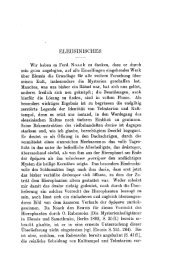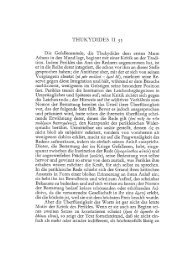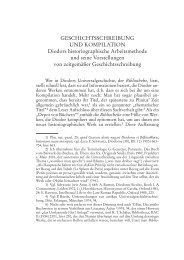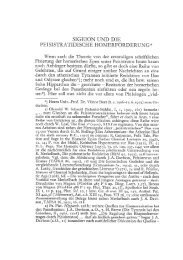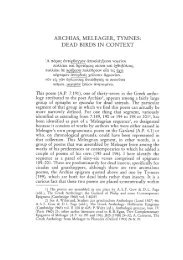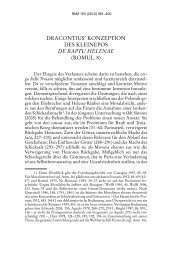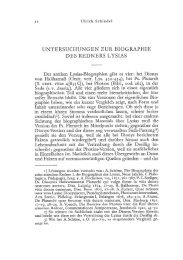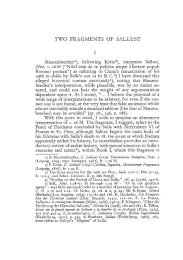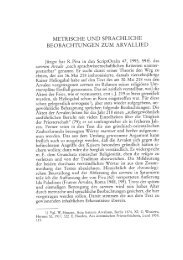APOTELESMATICA 2. (1) 14–140: SOURCES AND MODELS*
APOTELESMATICA 2. (1) 14–140: SOURCES AND MODELS*
APOTELESMATICA 2. (1) 14–140: SOURCES AND MODELS*
Create successful ePaper yourself
Turn your PDF publications into a flip-book with our unique Google optimized e-Paper software.
86 Maria Ypsilanti<br />
Anonymus 1,5 (Maass 94, l. 28 f.) report that it is the Egyptians<br />
who call the Claws Balance. The explanation of Pseudo-Manetho<br />
is similar to that of Schol. on Arat. 88, who gives, however, one<br />
more alternative. 44<br />
Aratus uses the Galaxy (469–79) as a means of comparison to<br />
the Equator and the Zodiac. The only other reference to the constellations<br />
Galaxy goes through in extant Greek literature is the<br />
detailed account of Ptolemy (Synt. Mathem. 8 b); accounts in Latin<br />
are that of Manilius (684–700) and Hyginus (4.7). In general, in his<br />
description of the Galaxy and its constellations (ll. 116–28), Pseudo-Manetho<br />
is closer to Manilius’ description than that of Hyginus<br />
and of Ptolemy; it is noteworthy that both Manilius and Pseudo-<br />
Manetho start from the polar circle to define the beginning of the<br />
Galaxy. 45 Manilius did use a globe with the Galaxy on it; 46 we do<br />
not know the exact position of the constellations this globe depicted<br />
on the other circles, since Manilius describes only the stars<br />
44) TaÊtaw d¢ ofl éstrolÒgoi ZugÚn e‰nai fas¤n, ≥toi ˜ti §mfere›w efis‹<br />
plãstiggi, μ ˜ti parå to›w pos¤n efis‹ t∞w Pary°nou. ÑH aÈtØ d° §sti D¤kh, ¥tiw tå<br />
zugå talanteÊei. Another explanation is that at this time of the year the farmers<br />
measure the grain and gather it into their homes, Sphaera 121 ff. (p. 164 ff. Maass).<br />
There are further views as well, for instance that the sign is the catasterised<br />
Palamedes who invented the balance, see A. Bouche-Leclercq, L’Astrologie<br />
Grecque (Paris 1899) 141 with n. <strong>2.</strong> It has been held that it is Hipparchus who<br />
invented the term zugÒw, see id. ibid. n. 1.<br />
45) Cf. R. Scarcia (et all.), Manilio, il poema degli astri, 2 vols. (Milan 1996)<br />
258. Hyginus is less precise on this point and, in his account about the constellations<br />
of the Galaxy, he follows the opposite order in regard to Manilius and Pseudo-Manetho.<br />
The differentiations between the Greek and the Latin poet in their<br />
accounts of the constellations of the Galaxy are: the Altar and “Orion’s top” over<br />
which the Galaxy passes (omitted by Manilius); the Bird’s Wings and the Charioteer’s<br />
knees (the Bird and the Charioteer are mentioned but their parts which are on<br />
the Galaxy are not specified by Manilius); Perseus’ right knee (Manilius refers<br />
vaguely to “the figure of Perseus”). The two authors agree in the inclusion of the<br />
sting (tail in Manilius) of Scorpio, if we interpret Pseudo-Manetho’s yÆr (l. 122) as<br />
Scorpio, which seems plausible, as it would be pointless to speak of the Beast’s sting.<br />
Ptolemy does not speak about Orion, while he includes the Kids, a part of the Dog,<br />
a part of Ophiouchus.<br />
46) The Galaxy was depicted on some globes (cf. An. I, p. 95 Maass, sti d¢<br />
ı katakexrism°now §n tª sfa¤r& khr“ leuk“), but not all (cf. Geminius 5.69 oÈx<br />
˜ristai d¢ aÈtoË tÚ plãtow, éllå katå m°n tina m°rh platÊterÒw §sti, katå d° tina<br />
stenÒterow. DiÉ ∂n afit¤an §n ta›w ple¤staiw sfa¤raiw oÈd¢ katagrãfetai ı toË<br />
gãlaktow kÊklow). It is a reasonable assumption that Manilius used a globe with the<br />
depiction of the Galaxy on it, see G. P. Goold, Manilius, Astronomica (Loeb edition),<br />
xxxiv.



